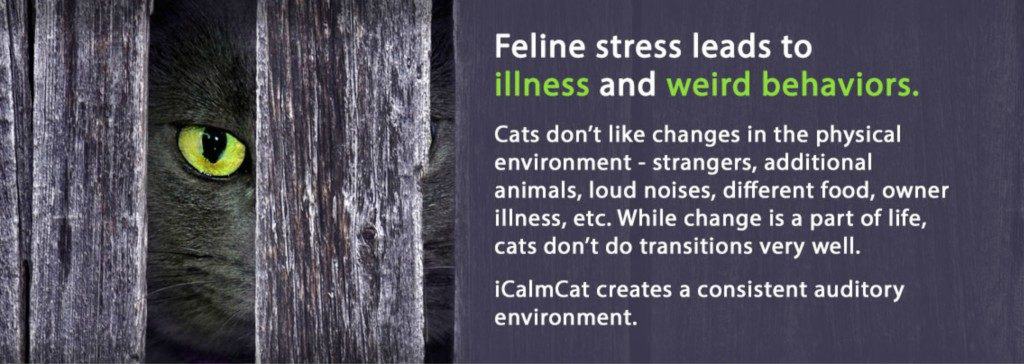Your cart is empty
“If you are interested in how iCalm music works with your pets… Grab a cuppa something and sit back and do some reading. Bottom line, I took my experience of creating specialized soundtracks for children in neurodevelopment clinics and began to apply many of the core psychoacoustic principles to our 4-leggeds. And they liked it – the music helped them to settle. And that’s how it all started in 2003.”
– Joshua Leeds
Sound researcher, Music producer, iCalmPet co-founder
iCalm Music for Dogs
 The music of iCalm (originally known as Through a Dog’s Ear) builds on the ground breaking psychoacoustic research of Dr. Alfred Tomatis (1920-2001). Known as the “Einstein of the ear,” Tomatis discovered the extraordinary powers of sound as a “nutrient for the nervous system.” His therapeutic discoveries redefine modern psychoacoustics — the study of the effect of music and sound on the human nervous system.
The music of iCalm (originally known as Through a Dog’s Ear) builds on the ground breaking psychoacoustic research of Dr. Alfred Tomatis (1920-2001). Known as the “Einstein of the ear,” Tomatis discovered the extraordinary powers of sound as a “nutrient for the nervous system.” His therapeutic discoveries redefine modern psychoacoustics — the study of the effect of music and sound on the human nervous system.
These recordings are psychoacoustically designed to support you and your dog’s compromised immune or nervous system function. When the immune or nervous system is heavily taxed, a natural reaction is to self-limit the amount of auditory or visual stimulation coming into the system. However, the “nutrients” of sound are needed the most when life energy is at a low ebb or when neurodevelopmental (including sensory) issues are present. To facilitate maximum sound intake while conserving energy output, the method of simple sound has been created.
The Psychoacoustic Rationale of iCalm Recordings
Auditory cognition in humans, as well as in dogs, is complex. When exposed to music, our brains methodically analyze every interval, rhythmic nuance, instrumental density, and melodic turn. When we’re young and healthy, we have abundant cerebral processing power to attend to many streams of sensory stimuli — be it sound, sight, touch, or smell. However, as we age, sensory tolerances decrease. When life energy is at a low ebb or when neurodevelopmental issues are present, music and sound can be a valuable source of arousal responses. However, the intricacies of conventional music often are too much for a depleted system to take in; music and sound may become mentally distracting, annoying, and even painful. This may lead to the individual retreating from auditory stimulation, therefore being deprived of sound’s beneficial vibrating effect.
The over-arching psychoacoustic theory informing iCalm music is summed up in just two words — simple sound. This term refers to the process of minimizing intricate auditory information found in most music. The music of Dog’s Ear is intentionally selected, arranged and recorded to provide easeful auditory assimilation. Three primary processes are used to accomplish this effect:
- Auditory Pattern Identification. To create less demanding arrangements, melodic and harmonic complexity has been considered and edited based on the desired relaxation or arousal response. Complexity encourages active listening; simplicity facilitates passive hearing. The recordings for dogs favor passive hearing as we believe that many of our canines suffer from over-stimulation.
- Orchestral Density.It is far less stressful on the nervous system to differentiate fewer instrumental colors than to interpret a full symphonic score. Therefore, solo piano provides a source of rich, full spectrum frequencies; additionally, duos and trios create a pleasing variety of easily assimilated orchestral colors.In our two years of clinical testing, the solo piano arrangements scored the highest in every category for the deepest canine relaxation.
- Resonance and Entrainment. To enhance mind/body states conducive to healing and wellness, the natural principles of resonance (tone) and entrainment (rhythm) are applied to every composition.
A final thought about this music and your furry buddy: The iCalm music use psychoacoustic techniques that naturally trigger relaxation or stimulated responses. Therefore, when first using these recordings, consider the level of relaxation or stimulation of your canine’s nervous system that best serves the situation.
Don’t be afraid to experiment with the music; it cannot hurt you or your pets. If you find that your dog or cat becomes agitated while listening, simply turn the music off or switch to a slower or faster CD or iCalm sound card. Your pet’s body will tell you what it needs… just be observant.
People have asked us why we created this music. One of the simple answers–as funny as it sounds–is to keep your pets off drugs (Just bark no!!!). While not a magic bullet for every canine issue, properly arranged music can have a very deep effect on you, your family, and your canines. Inexpensively and without ongoing side effects… healthy nervous function can prolong life and we believe this music is a component of that endeavor.
Bottom line, the music of Through a Dog’s Ear is an extremely effective tool to speed up or slow down the nervous system using the most beautiful music in the world!
iCalm Music for Cats
Since the 2008 release of Through a Dog’s Ear, requests for music designed for cats have been constant. As a research-based organization, we’ve demurred; there has been minimal scientific examination of music and sound with cats. However, research by Dr. C.A. Tony Buffington (2011, Ohio State University) caught my attention. While studying feline interstitial cystitis (a leading cause of euthanasia), researchers discovered a primary cause of this ailment: stress! Change in the cat’s physical environment–such as strangers, different food, additional animals, loud noises, etc.–is a major contributor. Cats prefer their homes to be stable and consistent. Acute feline stress turns into chronic irritation, manifesting in disease and behavioral challenges.
Calming is designed to reduce stress in a chaotic or unsettling environment. My sonic toolkit originates from sound therapies with neurodevelopmentally- challenged humans in which tone, tempo, and pattern are specially considered. Frequency ranges have been adjusted to a cat’s auditory range and a technique called sonic anchoring is included.
With best of intentions, people bring pets into a human sensory environment and expect quick adaptation. Sometimes animals adjust easily… and many times they can’t. The goal of BioAcoustic Research is to understand and create positive auditory programs to help domesticated animals find balance.
Similar to people, each animal’s sensory perception is different. Also, what calms your cat one day may not calm him the following. For some cats, our soundtracks are magic. We continue to try new things with the knowledge that beautiful music won’t harm our beloved animals as we continue to learn and innovate.
What is the difference between the calming music for dogs and cats?
The use of Sonic Anchoring and Frequency Modulation (explained in detail below) in music for cats.
Recent research by Dr. C.A. Tony Buffington (2011, Ohio State University) reported a primary cause of feline interstitial cystitis (a leading cause of euthanasia) is stress! Change in the cat’s physical environment—strangers, different food, additional animals, loud noises, illness, etc.—is a major contributor. Cats prefer their homes to be stable and consistent. Acute feline stress turns into chronic irritation, manifesting in disease and behavioral challenges.
We’ve brought consistency to cats with sonic anchoring.
What is Sonic Anchoring?
Our goal is to create a mental and emotional sense of safety that arises from familiarity. We accomplish this through a recognizable sequence of notes. While people hear these interludes as repeating melodic intervals, perhaps cats cognitively categorize this information as a familiar frequency matrix. Cats are not so much hearing the melody, but feeling a sequence of vibrational frequencies, particularly when they are lying near their iCalmCat. Like sensory information we instantly recognize – a favorite taste or aroma, our best friend’s voice, a mother’s touch–familiar sensory cues can have a profound and calming impact on the nervous system while providing psychological security.
What is Frequency Modulation?
To further focus the therapeutic impact, we’ve removed higher frequencies from the re-arranged piano music. Frequency modulation (FM) also takes place in the mid-and low-frequency ranges. Essentially, by reducing or boosting specific nutrients of sound, the resonance affects the nervous system. Through progressive FM, “arousing” frequencies are reduced and “soothing” frequencies are increased.
What’s the difference between iCalmCat Calming and Through a Cat’s Ear: Music to Calm?
iCalmCat (iCalm sound card format) is an expanded three hours of calming music specially designed for cats. When played on the on iCalmCat player, it automatically auto-repeats. The CD, Through a Cat’s Ear Vol. 1, is 1 hour of music and auto repeat only if your CD player is set on that function.
What if I have a Dog and a Cat?
Dogs and kitties alike often enjoy each other’s music. How can you tell? Observe your dogs and cats. Do they show any preference for either iCalmDog or iCalmCat? You can also mix it up and play both for both species.
Consider the iCalmCat series an adjunct to wonderful enrichment programs. Used together, you can exercise your cat’s innate animal instincts while keeping her safe and sound—purring on the corner of your bed and chasing your playful toes.
Psychoacoustic Techniques in iCalm Music for Pets and People
What is ‘active listening’ and ‘passive hearing’?
Auditory pattern identification and orchestral density techniques facilitate the middle-ear processes of active listening or passive hearing. Active listening takes place when the auditory mechanism is fully engaged. This occurs when we cannot find a pattern in the soundtrack, or when we are truly focused on listening. Conversely, the state of passive hearing transpires when we hear sounds around us but don’t pay conscious attention to them. On Essential Sound, passive hearing techniques facilitate relaxation; active listening techniques stimulate the nervous system.
What is resonance?
Resonance is the impact of one vibration upon another, i.e., something external sets something else into motion, or changes its vibratory rate. The palpable vibration of a sound wave has resonant effects upon each of us. According to Dr. Tomatis, high sounds tend to charge the nervous system, whereas lower sounds tend to discharge the nervous system.
What is entrainment and why are beats per minute important?
Due to the natural process of entrainment, the heartbeat, breath, and brainwaves speed up or slow down to match an external periodic rhythm. Fast rhythms excite our pulses, as well as our canines; slow rhythms calm us all down.

